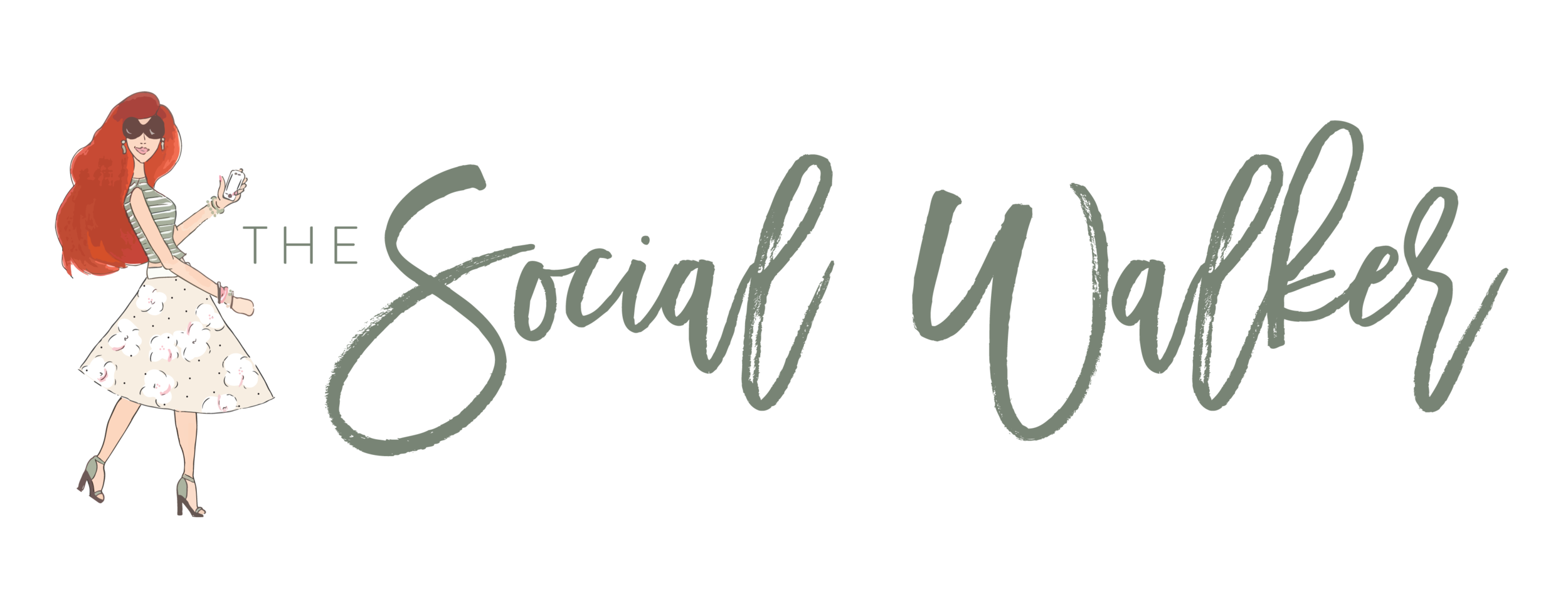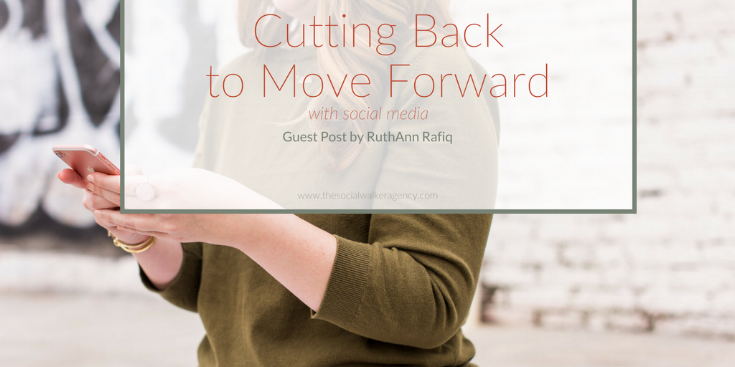Cutting Back to Move Forward with Social Media
Guest Post by: RuthAnn Rafiq
Social media is one of the best and worst things for your creative business.
When I say worst, I mean it’s super time consuming, it can get you wrapped up in things that don’t matter like how many followers you have, how many likes you receive (otherwise known as “vanity metrics”) and it can be a time-suck if you struggle with staying focus. Shiny object syndrome anyone?
But enough of the bad stuff. Social media is also one of the BEST things you can do for your business because you can build a true community, one that is mutually supportive and encouraging, one where your audience can get to know you and trust you and ultimately buy from you.
But in order to get the very best out of social media I’ve discovered that you need to cut back to move forward. Let me share 3 ways I have cut back on my own social media and in turn have moved forward in my business.
Make a Plan
I started my business a little over a year ago and, like most new creative entrepreneurs, I jumped in head-first, without a lot of planning, business knowledge or skill about time-management, finances, marketing... The list goes on and on.
After several months of posting to social media, making connections, and blogging regularly, I found that A) progress is slow-going and B) burn-out is a real thing.
Burnout happens when you start something with enthusiasm, and that excitement is your driving force. It’s great until your excitement wears out.
That’s why having a plan is the best way to start anything new, whether it be a diet, a business, or a social media platform. A plan will keep you focused, motivated and committed.
What having a Plan Looks Like
Know your goals
It’s important to know the reason you’re on certain platforms. If you’re on 10 different platforms and you don’t really know how each one is helping you, you just think “the more platforms I’m on the better the exposure” then you’ve probably believed the lie that quantity is better than quality.
That’s why, when choosing a platform it’s best to know HOW the platform is helping you, and WHY it’s the best fit for your business.
Know what “success” looks like to you
It’s also good to know what your “end goal” is. This can be a short-term end goal or a long-term one.
It’s good to have a healthy mix of both so when you reach a goal you can celebrate and move on to the next one. Likewise, when you don’t reach a goal you know that you need to put in a little more time and effort.
Plan out your content
Having a plan looks like knowing your goals, knowing what success looks like and planning out your content. Planning out content is a huge stress-reliever that can take a lot of the worry out of social media.
This can look like choosing photos and captions for Instagram and scheduling them on a helpful IG planner such as Later or Planoly (both free), or it can look like planning out Facebook posts the week ahead of time, and scheduling them accordingly.
I know of several apps that can help you schedule out ALL social media such as MeetEdgar, Buffer or Hootesuite (none of which I have tried myself).
Whether you choose to go with a scheduling app or the old-fashioned way of writing down general topics for each week, planning out content can make social media a lot more enjoyable and less stressful.
Choose to focus on 2–3 platforms
I’m only active on 3 platforms: Instagram, Facebook, and Pinterest. Although I’ve heard from people who care about me that I should be on LinkedIn, or SnapChat or Twitter, I smile and say, “no thanks.”
The truth is I only have so much time in the day. I am currently a side hustler, meaning I work on my business after I get home from my day job. So right there, I am already struggling to keep up with client work and my blog, not to mention social media platforms.
Cutting down to 3 platforms does several things for me: It helps me feel more in control, it allows me to engage more fully on those limited platforms (quality trumps quantity every time) and it saves me time.
Neil Patel, brilliant online business owner and marketer, suggests that you should be on only 1 platform if you’re newer to business. His reasoning is that you want to not only be good on that platform, but dominate it.
I’ve found that each platform helps me in different ways and having a little mix gives me a better range of reaching my audience. For instance, I use Pinterest to (primarily) boost my blog and since 75% of my web traffic comes from Pinterest, I know that this is a good strategy for me. I love Facebook for the groups. In the groups I’m able to have conversations about struggles, solutions and I can interact on a more “conversational” level. Instagram is a way for me to share my work, inspiration and my daily life.
As you can see, each platform has their benefits. I highly recommend cutting down on your platform usage if you feel like you’re drowning on the social media front.
Know your strengths
One way to help you choose which platform is right for you is to look at your personality and see where your strengths are.
If you’re great in front of the camera and have the personality and confidence for video, maybe your should start a YouTube channel or do Facebook live or Webinars. Connecting in this way will help you thrive by playing up your strengths.
If you prefer writing, Instagram is a great space for writing longer posts, or you can maintain a blog on your website, or you can guest post for other established industry peers.
If you’re in a more professional space maybe LinkedIn would be a great fit.
No matter what industry you’re in, you can find a platform that works great for both your personality and your business.
Know your audience
Another very important thing to consider before choosing a platform, is your audience.
Find out who your audience and where they like to hang out. If you audience is primarily female, then maybe Pinterest is a great platform for you because 80% of the users are women.
Facebook has a healthy gender mix and has a pretty broad user base, so if you’re not sure who your audience is, Facebook is a good place to start.
There are a lot of ways to find out where your audience likes to hang out.
If you’re not sure and want to find out you can do it the creepy way and stalk people, or you can simply ask those who you think could be a great fit for your audience, you can conduct a survey.. the options are endless.
It’s always a good practice to keep your audience top of mind when deciding how to communicate with them.
Stay Consistent and Make Engagement the Goal
The ultimate goal for social media and marketing is to connect, so don’t get discouraged if you don’t have many followers or likes.
Make yourself available, attentive and genuine and this will help you connect with your audience.
When you make real connections it builds the “know, like, and trust” factor which can go very far with getting inquiries and potential customers.
But connecting is just one step in the right direction. It’s equally important to be consistent as well as making connections.
One of the many mistakes I’ve made in my business is to go quiet on a platform for a month or two. Doing this leaves people wondering where you went and it can erode trust.
As you build your audience and engagement it’s vitally important that you remain consistent.
Do your best to stay visible, thoughtful, and be ready to connect and you’re sure to thrive with social media as a tool to grow your business.
So to wrap up, it’s important that you have a plan for your social media, know why you’re on the platforms you’re on, then make a content calendar to lessen the overwhelm. I recommend choosing 2–3 platforms that you can do very well on (both for your personality and your audience) and focus on those. Once you start building an audience, keep engagement at the forefront of your efforts and build trust by staying consistent.
More About RuthAnn
RuthAnn Rafiq is the brand designer and lady boss behind R Artspace, an all-inclusive branding studio that offers brand identity, brand photography and web design. She thrives on genuine connections and encouraging others. Some of her favorites include stove-cooked popcorn, zumba, soul music, a good book and spending time with her husband.



